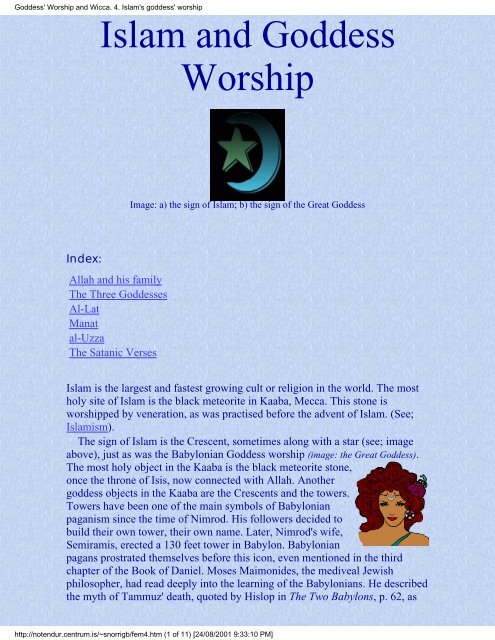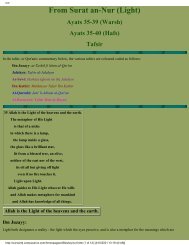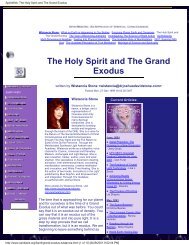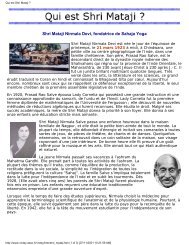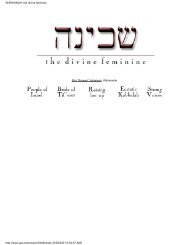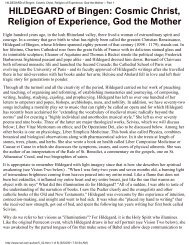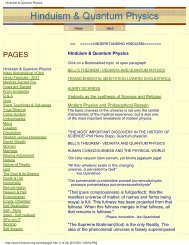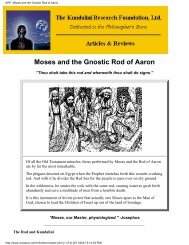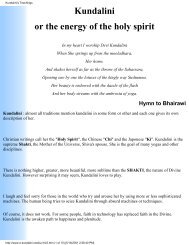Goddess' Worship and Wicca. 4. Islam's goddess ... - Al-Qiyamah
Goddess' Worship and Wicca. 4. Islam's goddess ... - Al-Qiyamah
Goddess' Worship and Wicca. 4. Islam's goddess ... - Al-Qiyamah
You also want an ePaper? Increase the reach of your titles
YUMPU automatically turns print PDFs into web optimized ePapers that Google loves.
<strong>Goddess'</strong> <strong>Worship</strong> <strong>and</strong> <strong>Wicca</strong>. <strong>4.</strong> <strong>Islam's</strong> <strong>goddess</strong>' worship<br />
Index:<br />
Islam <strong>and</strong> Goddess<br />
<strong>Worship</strong><br />
<strong>Al</strong>lah <strong>and</strong> his family<br />
The Three Goddesses<br />
<strong>Al</strong>-Lat<br />
Manat<br />
al-Uzza<br />
The Satanic Verses<br />
Image: a) the sign of Islam; b) the sign of the Great Goddess<br />
Islam is the largest <strong>and</strong> fastest growing cult or religion in the world. The most<br />
holy site of Islam is the black meteorite in Kaaba, Mecca. This stone is<br />
worshipped by veneration, as was practised before the advent of Islam. (See;<br />
Islamism).<br />
The sign of Islam is the Crescent, sometimes along with a star (see; image<br />
above), just as was the Babylonian Goddess worship (image: the Great Goddess).<br />
The most holy object in the Kaaba is the black meteorite stone,<br />
once the throne of Isis, now connected with <strong>Al</strong>lah. Another<br />
<strong>goddess</strong> objects in the Kaaba are the Crescents <strong>and</strong> the towers.<br />
Towers have been one of the main symbols of Babylonian<br />
paganism since the time of Nimrod. His followers decided to<br />
build their own tower, their own name. Later, Nimrod's wife,<br />
Semiramis, erected a 130 feet tower in Babylon. Babylonian<br />
pagans prostrated themselves before this icon, even mentioned in the third<br />
chapter of the Book of Daniel. Moses Maimonides, the mediveal Jewish<br />
philosopher, had read deeply into the learning of the Babylonians. He described<br />
the myth of Tammuz' death, quoted by Hislop in The Two Babylons, p. 62, as<br />
http://notendur.centrum.is/~snorrigb/fem<strong>4.</strong>htm (1 of 11) [24/08/2001 9:33:10 PM]
<strong>Goddess'</strong> <strong>Worship</strong> <strong>and</strong> <strong>Wicca</strong>. <strong>4.</strong> <strong>Islam's</strong> <strong>goddess</strong>' worship<br />
follows:<br />
When the false prophet named Thammuz preached to a certain king that<br />
he should worship the seven stars <strong>and</strong> the twelve signs of the Zodiac, that<br />
king ordered him to be put to a terrible death. On the night of his death<br />
all the images assembled from the ends of the earth into the temple of<br />
Babylon, to the great golden image of the Sun, which was suspended<br />
between heaven <strong>and</strong> earth. That image prostrated itself in the midst of the<br />
temple, <strong>and</strong> so did all the images around it, while it related to them all<br />
that had happened to Thammuz. The images wept <strong>and</strong> lamented all the<br />
night long, <strong>and</strong> then in the morning they flew away, each to his own<br />
temple again, to the ends of the earth.<br />
Those familiar with the Biblical story of Daniel's friends should recognize this.<br />
The whole world bowed down in worship for the king's pagan gold image. The<br />
astonishing issue is, however, that Muslims still do. The prostrate themselves in<br />
the direction (qibla) of the former Goddess symbols in Mecca, now <strong>Al</strong>lah's<br />
sanctuary.<br />
From the beginning, towers or obelisks were symbols of pagan worship as<br />
conducted in Babylon <strong>and</strong> Egypt, <strong>and</strong> later all around the world. The obelisk<br />
was originally a symbol of Baal (Nimrod) <strong>and</strong> sexual rituals in the context of<br />
sun-worship. We also see these matzebah images in various places in the Bible,<br />
such as I Kings 14:23, 2 Kings 18:4, 23:14; Isaiah 17:8, 27:9; Jer. 43:13; Ezk.<br />
8:5; Micah 5:13).<br />
The name of Artemis, a version of Semiramis, probably meant "women who<br />
built towers", Cybele <strong>and</strong> Diana, another versions of Semiramis, were pictured<br />
carrying a tower, <strong>and</strong> we can trace this all the way Japan <strong>and</strong> China in the east,<br />
to Indians in America, the Vikings of the North <strong>and</strong> Africans in the South. We<br />
always see this tower connected with pagan worship, <strong>and</strong>, unfortunately, later<br />
adopted by the Roman Catholic church. And, of course, Islam has not only<br />
adopted the tower (minaret) but also the worship of meteorites, the Crescent<br />
<strong>and</strong> the Babylonian Star. And to conclude this discussion, <strong>Al</strong>lah himself was<br />
originally a pagan deity, related to astrological fertility worship <strong>and</strong> various<br />
other aspects of Babylonian paganism.<br />
<strong>Al</strong>lah <strong>and</strong> His Family<br />
Muslims usually argue that their ‘<strong>Al</strong>lah’ is the same deity as the<br />
Judeo-Christian God. For sincere Jews or Christians, that statement ought to be<br />
considered as a profound blasphemy, since it destroys their concept of God. By<br />
accepting such a thesis one is admitting Islam as the true religion, above<br />
Judaism <strong>and</strong> Christianity. One has not come across any arguments that can<br />
prove that ‘<strong>Al</strong>lah’ is just another name for the Judeo-Christian God. The<br />
Islamic scholar Caesar Farah states: "There is no reason, therefore, accept the<br />
idea that <strong>Al</strong>lah passed to the Muslims from the Christians <strong>and</strong> Jews." (Ceasar<br />
Farah, Islam: Beliefs <strong>and</strong> Observations (New York, 1987), 28.) And as their characters<br />
http://notendur.centrum.is/~snorrigb/fem<strong>4.</strong>htm (2 of 11) [24/08/2001 9:33:10 PM]
<strong>Goddess'</strong> <strong>Worship</strong> <strong>and</strong> <strong>Wicca</strong>. <strong>4.</strong> <strong>Islam's</strong> <strong>goddess</strong>' worship<br />
are examined, they seem to be of a completely different nature <strong>and</strong> reveal<br />
contradicting scriptures.<br />
‘<strong>Al</strong>lah’, in fact, has a genealogy that can be traced through Yemen to Babylon,<br />
the mother of all idolatry. In Babylon, paganism began at the time of Nimrod,<br />
the alleged builder of the Tower of Babel. After the confusion of languages,<br />
Babylonian idolatry spread all over the world. Nimrod had been dei-fied <strong>and</strong><br />
was known as Baal, Molech,.... <strong>and</strong> finally, as <strong>Al</strong>lah. The Baal worship was<br />
conducted by sacrifices, prostrations <strong>and</strong> kissing the idol, (See I. Kings 19:18)<br />
which was the same type of service conducted at the Kaaba <strong>and</strong> other places in<br />
Arabia. There are also traces of a direct Baal worship among the Arabs: "And<br />
God helped him [King Uzziah of Juda] against the Philistines, <strong>and</strong> against the<br />
Arabians that dwelt in Gur-baal, <strong>and</strong> the Mehunims [probably Mineanites from<br />
Yemen]." (II Chron. 26:7) It was common to add Baal’s name to the city where<br />
he was worshipped <strong>and</strong> thus it was obviously so in Gur. Inscriptions with<br />
Baal’s name have been found in Central Arabia at some oasis where Arabian<br />
inhabitants had settled. The great scholar William Robertson Smith argues that<br />
the<br />
most developed cults of Arabia belong not to the pure nomads, but to<br />
these agricultural <strong>and</strong> trading settlements, which the Bedouin visited<br />
only as pilgrims, not to pay stated homage to the lord of the l<strong>and</strong> from<br />
which they drew their life, but in fulfilment of vows. (William Robertson<br />
Smith, The Religion of the Semites. The Fundamental Institutions (London, 1902),<br />
109.)<br />
Concerning the Kaaba, Muslims' holiest place, Ibn Ishaq gives us an example<br />
of such fulfilment of vows, when he reports the story of a Jurhum woman who<br />
"had been barren <strong>and</strong> vowed to <strong>Al</strong>lah that if she bore a son she would give him<br />
to the Kaaba as a slave to serve it <strong>and</strong> to look after it." (quoted in; Guillaume, The<br />
Life of Muhammad, 49.) In Mesopotamia, <strong>and</strong> consequently in all the known<br />
world, the firstfruits of the crops or cattle were sacrificed to the fertility god. A<br />
sacred plot of l<strong>and</strong> was offered to the deity, where he could abide <strong>and</strong> accept<br />
their offerings. In Mecca, the earlier fertility god named Baal was replaced with<br />
desert gods, the Aramaic <strong>Al</strong>lah <strong>and</strong> the Yemenite Hubal.<br />
The ancient world usually worshipped a pantheon of gods, where higher <strong>and</strong><br />
lesser gods battled for supremacy. <strong>Al</strong>l these pantheons had many similarities,<br />
for example, always including a relationship between a high male-god <strong>and</strong> a<br />
mother<strong>goddess</strong>. Religious beliefs were often a spiritual form or the exaltation<br />
of the society the worshippers happened to be a part of. In primitive tribal<br />
societies, the family was the integral part which formed the basis of solidarity,<br />
wealth, protection <strong>and</strong> daily support. Thus, a family of deities was the normal<br />
state of worship.<br />
In Arabian archaeology a large number of inscriptions on rocks, tablets <strong>and</strong><br />
walls, have pointed to the worship of a family of four; one male <strong>and</strong> his three<br />
‘daughters’ or <strong>goddess</strong>es. Those three <strong>goddess</strong>es are sometimes engraved<br />
together with <strong>Al</strong>lah, represented by a crescent moon above them. But <strong>Al</strong>lah was<br />
the ‘Lord of the Kaaba... Lord of Manat, al-Lat, <strong>and</strong> al-Uzza...<strong>and</strong> even as<br />
http://notendur.centrum.is/~snorrigb/fem<strong>4.</strong>htm (3 of 11) [24/08/2001 9:33:10 PM]
<strong>Goddess'</strong> <strong>Worship</strong> <strong>and</strong> <strong>Wicca</strong>. <strong>4.</strong> <strong>Islam's</strong> <strong>goddess</strong>' worship<br />
‘Lord of Sirius’.’(Peters, Muhammad, 98.) His ‘daughters’ were his associates,<br />
helpers <strong>and</strong> were themselves worshipped, after the manner of ancient<br />
Babylonian customs <strong>and</strong> symbolised by astronomical symbols.<br />
The Three Goddesses<br />
Mediterranean mythology included the worship of the Mother <strong>goddess</strong> who<br />
appeared under three natures, names <strong>and</strong> faces. Adam McLean, a leading<br />
authority on <strong>goddess</strong>es, states:<br />
The triplicity of the Goddess is very important. This is not merely a<br />
multiplying by three, but rather a threefold manifestation; the Goddess<br />
reveals herself on three levels, in the three realms of the world <strong>and</strong> of<br />
humankind.<br />
Those three faces correspond to heaven, earth <strong>and</strong> the underworld; or past,<br />
present <strong>and</strong> future. McLean continues:<br />
The most important triple aspect of the Goddess is her manifestation as<br />
Virgin/Mother/Crone. This is perhaps the easiest representation with<br />
whom people can identify, as this triplicity corresponds to the three<br />
phases of woman’s life... the Young Woman/Mother/Old woman. (Adam<br />
McLean, The Triple Goddess. An Exploration of the Archetypal Feminine (Gr<strong>and</strong><br />
Rapids, 1989), 14-15.)<br />
It is noteworthy that those three <strong>goddess</strong>es were, in certain places, represented<br />
by meteorites or aeroliths, stones that had fallen from heaven, just as the Kaaba<br />
stone in Mecca. (Ibid, 52.) Merlin Stone noted that in Aphrodite’s temple in<br />
Cyprus a certain stone was anointed by oil each year at the feast of the <strong>goddess</strong>.<br />
The same stone worship was conducted at Baalat’s temple at Byblos. (As <strong>Al</strong>lat<br />
was the feminine version of <strong>Al</strong>lah, so was Baalat the feminine version of Baal.)<br />
The Romans venerated the captured Carthagian stone-<strong>goddess</strong> Cybele <strong>and</strong> also<br />
the Greeks in Asia Minor. (Merlin Stone, ‘Goddess <strong>Worship</strong> in the Ancient Near East’ in<br />
Religions of Antiquity, 65-66.) Concerning our subject, we find the same<br />
character-istics. <strong>Al</strong>l over Arabia, these same symbols have been found as<br />
representing the worship of a triple Arabian <strong>goddess</strong>es. McLean states:<br />
Long before the coming of the austere patriarchal system of Islam, the<br />
Arabic people worshipped this trinity of desert Goddesses who were the<br />
three facets of the one Goddess. <strong>Al</strong>-Uzza (‘the mighty’) represented the<br />
Virgin warrior facet; she was a desert Goddess of the morning star who<br />
had a sanctuary in a grove of acacia trees to the south of Mecca, where<br />
she was worshipped in the form of a sacred stone. <strong>Al</strong>-Lat, whose name<br />
means simply ‘Goddess’, was the Mother facet connected with the Earth<br />
<strong>and</strong> its fruits <strong>and</strong> the ruler of fecundity. She was worshipped at At-Ta’if<br />
near Mecca in the form of a great uncut block of white granite. Manat,<br />
the crone facet of the Goddess, ruled fate <strong>and</strong> death. Her principal<br />
sanctuary was located on the road between Mecca <strong>and</strong> Medina, where<br />
she was worshipped in the form of a black uncut stone. (McLean, The<br />
Triple Goddess, 80.)<br />
http://notendur.centrum.is/~snorrigb/fem<strong>4.</strong>htm (4 of 11) [24/08/2001 9:33:10 PM]
<strong>Goddess'</strong> <strong>Worship</strong> <strong>and</strong> <strong>Wicca</strong>. <strong>4.</strong> <strong>Islam's</strong> <strong>goddess</strong>' worship<br />
This <strong>goddess</strong> appearing under many names throughout the world of antiquity is<br />
the same as was represented as Baal’s wife. She was called Astarte, Semiramis,<br />
Ashtaroth, Isis, Venus, Fortuna, Diana, Asherah, Elat, etc.. Indeed, Isis was<br />
known as the mother of one thous<strong>and</strong> names. However, regardless of her<br />
various titles, she was Baal’s wife <strong>and</strong> worshipped as such. (Judges 2:13). Baal<br />
is said to have had three daughters, who were apparently called by different<br />
names around the ancient world. (Cooper, Canaanite Religion, 86.) They were also<br />
considered his brides, with whom he swore to build a house. The ‘Building<br />
Saga’ is discussed in (Julian Obermann, Ugaritic Mythology. A Study of Its Leading<br />
Motifs (New Haven, 1948)). The Quraysh adopted <strong>Al</strong>lah as Baal, <strong>and</strong> added the<br />
<strong>goddess</strong>es to his cult the same way as Baal had three daughters in the Fertile<br />
Crescent. They venerated him <strong>and</strong> his three female companions in his new<br />
House, the Kaaba at Mecca.<br />
One of the aspects of <strong>goddess</strong> worship that has survived in Islam, as well as,<br />
for example, in Roman Catholicism, is the rosary. Through the ages the<br />
worshippers of <strong>goddess</strong>es had used the rosary for prayers <strong>and</strong> it is still in use in<br />
the worship of female deities all over the world, for example by Hindus in<br />
India. The rosary is connected with fertility worship when the deity’s name is<br />
repeated over <strong>and</strong> over again. (Compare to Matthew 6:7-13 <strong>and</strong> Acts 19:3<strong>4.</strong>) It<br />
is called tasbih or subha in Arabic, <strong>and</strong> simply means ‘an object which one<br />
praises.’ The Muslim rosary is supposed to contain 99 beads, representing the<br />
titles of ‘<strong>Al</strong>lah’, but usually it only has 33 beads, slipped through one’s fingers<br />
three times. (Compare to the Koran 7:180.) This pagan custom, which is dated<br />
to Astarte worship from about 800 BCE, still survives in Islam as well as in<br />
many other cults around the world.<br />
Ancient Middle Eastern mythology often pictured the Mother <strong>goddess</strong> with a<br />
son, such as Isis-Horus in Egypt <strong>and</strong> Astarte-Tammuz in the Fertile Crescent.<br />
This mother-son worship was established throughout the world. In China there<br />
was the Mother Shingmoo, Hertha in ancient Germany, Nutria in ancient Italy<br />
(Etrusca), Indrani in India, Aphrodite in Greece, Venus in Rome, Cybele in<br />
Asia Minor <strong>and</strong> Carthage, Diana in Ephesus, Isis in Egypt etc.. In Hijaz, on the<br />
other h<strong>and</strong>, there was no harvest <strong>and</strong> thus no worship of fertility gods as such.<br />
Its patriarchal society soon changed the ancient mother-son worship to<br />
father-daughter worship. <strong>Al</strong>lah was the father, <strong>and</strong> his daughters were <strong>Al</strong>-Lat,<br />
Manat <strong>and</strong> al-Uzza.<br />
<strong>Al</strong>-Lat (<strong>Al</strong>lat)<br />
<strong>Al</strong>-Lat, the female version of the Aramaic <strong>Al</strong>lah, was the ‘Lady of the<br />
Temple’ at the Semitic Pantheon of Palmyra, frequently mentioned in sources<br />
from ancient periods. Her cult was shared by the tribes of Bene Maazin <strong>and</strong><br />
Bene Nurbel in that city. The former tribe probably provided the guardians or<br />
priests for her sanctuary, which was probably established after the Nabatean<br />
occupation of Syria, including Damascus, in 85 BCE. (Javier Teixidor, The<br />
Pantheon at Palmyra, 55-58.)<br />
<strong>Al</strong>-Lat was the mother <strong>goddess</strong> (al-Ilahah), representing the sun. She was the<br />
http://notendur.centrum.is/~snorrigb/fem<strong>4.</strong>htm (5 of 11) [24/08/2001 9:33:10 PM]
<strong>Goddess'</strong> <strong>Worship</strong> <strong>and</strong> <strong>Wicca</strong>. <strong>4.</strong> <strong>Islam's</strong> <strong>goddess</strong>' worship<br />
mother figure among the gods <strong>and</strong> <strong>goddess</strong>es, the Great Earth Mother of<br />
ancient mythology, <strong>and</strong> the Astarte of the Arabs. Javier Teixidor states:<br />
It is not surprising to find at Palmyra different names for the same deity.<br />
<strong>Al</strong>lat ... Astarte ... all conceal one sole <strong>goddess</strong>, the female deity of<br />
heaven in whose cult Arab Palmyrenes as well as members of the<br />
western tribes were united. (Ibid, 61.)<br />
She was brought to the Hijaz from Palmyra, probably through Teima. <strong>Al</strong>fred<br />
Guillaume states:<br />
<strong>Al</strong>-Lat... is mentioned by Herodotus; in old Arabian inscriptions; <strong>and</strong> in<br />
the pre-Islamic poets; <strong>and</strong> was the great mother <strong>goddess</strong> who, under<br />
various names, was worshipped all over the ancient world. Ta’if, a town<br />
near Mecca, was the centre of her worship [in Arabia proper]. (Guillaume,<br />
The Life of Muhammad, 24, 38.)<br />
In Ta’if there was a temple dedicated to al-Lat, (Guillaume, Islam, 7.) the city’s<br />
deity, according to Ibn Ishaq, <strong>and</strong> she was represented by a square-stone. (Hitti,<br />
History of the Arabs, 98 ). The Mother <strong>goddess</strong> was often repres-ent-ed by a<br />
stone, mountain, cave, pillar or rock. Stones are among the oldest symb-ols of<br />
Mother worship, as Erich Neumann discussed in detail. (Erich Neumann, The<br />
Great Mother (Princeton, 1953/1991), 260.) The Meccans had been on friendly terms<br />
with the Ta’ifians, especially since most of their food was bought or grown in<br />
Ta’if, <strong>and</strong> that city was also the main commercial centre in the Hijaz, since it<br />
lay on the Yemen-Mesopotamia overl<strong>and</strong> trading route. According to Ibn<br />
al-Khalbi:<br />
<strong>Al</strong>-Lat stood in al-Ta’if <strong>and</strong> was more recent than Manat. She was a<br />
cubic rock beside which a certain Jew used to prepare his barley<br />
porridge. Her custody was in the h<strong>and</strong>s of Banu Attab ibn Malik of the<br />
Thaqif, who had built an edifice over her.... The Quraysh, as well as all<br />
the Arabs, were wont to venerate al-Lat. They used to name their<br />
children after her, calling them Zayd al-Lat <strong>and</strong> Taym al-Lat. (Quoted in<br />
Peters, Muhammad, 110).<br />
The Nabateans also venerated <strong>Al</strong>lat as the ‘mother of the gods’, the same as the<br />
Urania of Hellenism. According to Tor Andrae:<br />
Thus we have a right to assume that in Arabic circles <strong>Al</strong>lat<br />
correspond-ed with the great Semitic <strong>goddess</strong> of motherhood, fertility<br />
<strong>and</strong> heaven, <strong>and</strong> especially with the form which she assumed in Western<br />
Semitic reg-ions. In Taif, where her most important sancturay was<br />
located, she was called simply <strong>Al</strong> Rabba, ‘sovereign’, a title which<br />
belonged also to Ishtar (Belit) <strong>and</strong> Astarte (Baalat). (Tor Andrae,<br />
Mohammad. The Man <strong>and</strong> His Faith (London, 1936), 17.)<br />
When Muhammed conquered Mecca <strong>and</strong> some of its neighbouring tribes, he<br />
turned to Ta’if <strong>and</strong> its temple of al-Lat. A Muslim poet said about the attack on<br />
Ta’if:<br />
Don’t help al-Lat for <strong>Al</strong>lah is about to destroy her.<br />
http://notendur.centrum.is/~snorrigb/fem<strong>4.</strong>htm (6 of 11) [24/08/2001 9:33:10 PM]
<strong>Goddess'</strong> <strong>Worship</strong> <strong>and</strong> <strong>Wicca</strong>. <strong>4.</strong> <strong>Islam's</strong> <strong>goddess</strong>' worship<br />
How can one who cannot help herself be helped?<br />
She was burned in black smoke <strong>and</strong> caught fire.<br />
None fighting before her stones, is an outcast.<br />
When the apostle descends on your l<strong>and</strong><br />
None of her people will be left when he leaves.<br />
(Guillaume, The Life of Muhammad, 588.)<br />
<strong>Al</strong>lat was the equivalent of Ishtar-Astarte in the mother-father Semitic cult<br />
worship. In contrast to the Fertile Crescent region, the Arabs worshipped her as<br />
the sun, not the moon which is masculine in Arabia. However, the Semitic cults<br />
connected the <strong>goddess</strong> worship with love, <strong>and</strong> thus, its absence with the<br />
opposite. As Erich Neumann states:<br />
Withdrawal of love can appear as a withdrawal of all the functions<br />
constituting the positive side of the elementary character. Thus hunger<br />
<strong>and</strong> thirst may take place of food, cold of warmth, defenselessness of<br />
protection, nakedness of shelter <strong>and</strong> clothing, <strong>and</strong> distress of<br />
contentment.... Consequently, the symbols of exile <strong>and</strong> desert also<br />
belong to the present context. (Neumann, The Great Mother, 67-68.)<br />
Thus, the Arabs were left with the loneliness of the desert <strong>and</strong> in order to make<br />
the best of the situation, the moon-<strong>goddess</strong> of the fertile l<strong>and</strong>s was transformed<br />
into the sun-<strong>goddess</strong> of the desert. <strong>Al</strong>-Lat was the Great Mother who fed her<br />
children as necessary. But when it came to fortune the Arabs turned to Manat.<br />
Manat<br />
Manat is believed to be the Arabs’ original <strong>goddess</strong>, appearing some time<br />
before al-Uzza <strong>and</strong> al-Lat. Her name appears in the house of Baal in 32 CE, but<br />
she originated much earlier among the Arabs. Manat seems to have arrived in<br />
Arabia from Palmyra, where she was worshipped along with Baal. She was<br />
venerated beside several other deities in a temple called ‘the house of the gods,’<br />
(Teixidor, The Pantheon of Palmyra 3, 12-18 — The Pagan god, 116.) the Palmyran<br />
equivalent of the Kaaba. Manat was the controller of the Arabs’ fortunes <strong>and</strong><br />
the mystery of life <strong>and</strong> death. She was the chief deity of al-Aus <strong>and</strong> al-Khazraj<br />
<strong>and</strong> other pagan inhabitants of Yathrib (Medina). It seems that she was<br />
represented by a wooden image, which was covered in blood during her<br />
worship. (Guillaume, The Life of Muhammad, 38-39, 207.) Manat’s sanctuary was in a<br />
place near Yathrib where the Aus <strong>and</strong> Khazraj visited on their way back from<br />
their pilgrimages to Mecca. Ibn al-Khalbi states:<br />
The Aus <strong>and</strong> Khazraj, as well as those Arabs among the people of<br />
Yathrib <strong>and</strong> other places who followed their way of life, were<br />
accustomed to go on Hajj <strong>and</strong> observe the ‘st<strong>and</strong>ing’ at all the appointed<br />
places, but not shave their heads [as was customary during the<br />
pilgrimage]. At the end of Hajj, however, when they were about to return<br />
home, they would set out to the place where Manat stood, shave their<br />
heads <strong>and</strong> stay there for a while. (Quoted in Peters, Muhammad, 110.)<br />
http://notendur.centrum.is/~snorrigb/fem<strong>4.</strong>htm (7 of 11) [24/08/2001 9:33:10 PM]
<strong>Goddess'</strong> <strong>Worship</strong> <strong>and</strong> <strong>Wicca</strong>. <strong>4.</strong> <strong>Islam's</strong> <strong>goddess</strong>' worship<br />
This <strong>goddess</strong> of fate <strong>and</strong> time in ancient paganism was revered <strong>and</strong> worshipped<br />
with the same zeal as the Mother figure itself. In Greece Moirai, the <strong>goddess</strong> of<br />
fate, was the daughter of the Night, as well as Moros <strong>and</strong> Erinyes (compare to<br />
al-Lat <strong>and</strong> al-Uzza). Attributed to the <strong>goddess</strong> of fate was the sharing of booty,<br />
l<strong>and</strong> <strong>and</strong> labour between clans. She was concerned with birth, marriage <strong>and</strong><br />
death <strong>and</strong>, in the relation with men, warfare <strong>and</strong> raids.<br />
Manat was much revered by the Arabs but her worship was dwindling at the<br />
time of Muhammed, probably due to Jewish influence in Medina. This shows<br />
how easily the al-Aus <strong>and</strong> al-Khazraj tribes were willing to ab<strong>and</strong>on their<br />
religion in favour of Islam.<br />
<strong>Al</strong>-Uzza<br />
Some sources say that al-Uzza was brought to Mecca by the Quraysh <strong>and</strong><br />
enjoined to the already established Kaaba worship, but she probably was a local<br />
deity in Mecca since the time of ‘Amr ibn Lubayy. In Muhammed’s time,<br />
al-Uzza was the most important of the Meccan local deities, perhaps save for<br />
‘the Lord’ Hubal. Her main sanctuary was in a valley called Hurad, just outside<br />
Mecca. ‘It was complete with a haram <strong>and</strong> a sacrificial altar.’ (Ibid, 110.)<br />
<strong>Al</strong>fred Guillaume states that evidence ‘for her worship from the fourth century<br />
AD is copious. Tradition states that in his youth Muhammad sacrificed a white<br />
sheep to her.’ The Arabs offered human sacrifices to al-Uzza <strong>and</strong><br />
the blood of the victims was smeared or poured on them while the<br />
tribes-men danced round the stone... The devotees licked the blood, or<br />
dipped their h<strong>and</strong>s in it, <strong>and</strong> thus a reciprocal bond held them to one<br />
another <strong>and</strong> the deity to whom the stone belonged. Nilus, a Christian<br />
writer, gives a fairly full account of such a sacrifice to Uzza. Though<br />
there is no trace of human sacrifices in the Quran, it is clear from the<br />
authority just quoted <strong>and</strong> from early Arab sources that human beings<br />
were sacrificed to these gods in Duma <strong>and</strong> Hira. (Guillaume, Islam, 8-9.)<br />
Ibn Ishaq states that al-Uzza had a slaughter place (ghabghab), where the blood<br />
was poured out. An Arab poet said:<br />
Asma’ was given as a dowry the head of a little red cow<br />
Which a man of the Banu Ghanm had sacrificed<br />
He saw blemish in her eye when he led her away<br />
To al-Uzza’s slaughter-place <strong>and</strong> divided her into goodly portions.<br />
Muhammed had, according to tradition, sacrificed a sheep to her, <strong>and</strong> it might<br />
very well be that it had been done at Mount Hira, which was now Muhammed’s<br />
place of devotion to the moon-god <strong>Al</strong>lah <strong>and</strong> his daughter al-Uzza. It has been<br />
stated that the Arabs sacrificed infant boys <strong>and</strong> girls to the morning star,<br />
al-Uzza. (Andrae, Mohammed, 17-18.) Ibn al-Khalbi states:<br />
The Quraysh as well as other Arabs who inhabited Mecca did not give to<br />
any of their idols anything similar to their veneration of al-Uzza. The<br />
next in order of veneration was <strong>Al</strong>-Lat <strong>and</strong> then Manat. (Peters,<br />
Muhammad, 111.)<br />
http://notendur.centrum.is/~snorrigb/fem<strong>4.</strong>htm (8 of 11) [24/08/2001 9:33:10 PM]
<strong>Goddess'</strong> <strong>Worship</strong> <strong>and</strong> <strong>Wicca</strong>. <strong>4.</strong> <strong>Islam's</strong> <strong>goddess</strong>' worship<br />
During the armed confrontation between the Meccans <strong>and</strong> Muhammed at Badr<br />
(AH 2), the former carried al-Uzza’s banner to battle. Tradition says that<br />
Muhammed sent Khalid ibn al-Walid, who later conquered Syria for Islam, to<br />
destroy al-Uzza’s temple in Nakhla. There, some of the tribes of Quraysh <strong>and</strong><br />
Kinana, <strong>and</strong> all the Mudar tribe, used to worship. When the guardian of al-Uzza<br />
heard that Khalid was approaching "he hung his sword on her, climbed the<br />
mountain on which she stood," <strong>and</strong> said:<br />
O ‘Uzza, make an annihilating attack on Khalid,<br />
Throw aside your veil <strong>and</strong> gird up your train<br />
O ‘Uzza, if you do not kill this man Khalid<br />
Then bear a swift punishment or become a Christian.<br />
However, according to tradition, Khalid <strong>and</strong> his army destroyed the al-Uzza<br />
idol <strong>and</strong> returned to Muhammed. (Guillaume, The Life of Muhammad, 565-566.)<br />
When these idols had all been destroyed, ‘<strong>Al</strong>lah’ reigned supreme in the Hijaz.<br />
The threefaced Mother Goddess had vanished from the visible sphere, but still<br />
lives in Muslim legends according to the ‘Satanic verses’.<br />
The ‘Satanic Verses’<br />
The chapter of Muhammed’s life the Muslims want to forget most of all is the<br />
affair of the ‘Satanic verses’, made worldfamous by Salman Rushdie’s novel by<br />
the same name. The setting is Mecca, some years before the hijra, most likely<br />
in 619 CE, when Muhammed’s protector, Abu Talib, <strong>and</strong> his wife, Khadija, had<br />
both died. The Meccans had become increasingly hostile towards him <strong>and</strong><br />
ridiculed his mission in every possible way. What was probably worse, they<br />
tempted Muhammed by promising him fame <strong>and</strong> fortune if he would refrain<br />
from attacking their deities. Muhammed was unwilling to compromise his<br />
mission <strong>and</strong> declined their offer. Then the next temptation came, as al-Tabari<br />
narrates:<br />
‘If you will not do so, we offer you one means which will be to your<br />
advantage <strong>and</strong> to ours.’ ‘What is it?’ he [Muhammed] asked. They said:<br />
‘You will worship our gods, al-Lat <strong>and</strong> al-’Uzza, for a year, <strong>and</strong> we shall<br />
worship your god for a year.’ ‘Let me see what revelation comes to me<br />
from my Lord’ he replied. Then, the following inspiration came from the<br />
Preserved Tablet [the Koran which ‘<strong>Al</strong>lah’ preserves in heaven]. (W. M.<br />
Watt <strong>and</strong> M. V. McDonald (transl. & annotators), The History of al-Tabari (volume<br />
IV: Muhammad at Mecca. New York, 1988), 107.)<br />
The continuation al-Tabari adopted from Ibn Ishaq’s narrative which stated:<br />
When the apostle saw that his people turned their backs on him <strong>and</strong> he<br />
was pained by their estrangement from what he brought them from<br />
<strong>Al</strong>lah, he longed that there should come to him from <strong>Al</strong>lah a message<br />
that would reconcile his people to him. Because of his love for his people<br />
<strong>and</strong> his anxiety over them, it would delight him if the obstacle that made<br />
his task so difficult could be removed; so that he meditated on the project<br />
<strong>and</strong> longed for it <strong>and</strong> it was dear for him. Then <strong>Al</strong>lah sent down ‘By the<br />
http://notendur.centrum.is/~snorrigb/fem<strong>4.</strong>htm (9 of 11) [24/08/2001 9:33:10 PM]
<strong>Goddess'</strong> <strong>Worship</strong> <strong>and</strong> <strong>Wicca</strong>. <strong>4.</strong> <strong>Islam's</strong> <strong>goddess</strong>' worship<br />
star when it sets your comrades errs not <strong>and</strong> is not deceived, he speaks<br />
not from his own desire.’ (Guillaume, The Life of Muhammad, 165.)<br />
Then Muhammed’s revelation continued: ‘Have you thought upon <strong>Al</strong>-Lat <strong>and</strong><br />
al-Uzza <strong>and</strong> on Manat, the third other? Are yours the males, <strong>and</strong> His the<br />
females?’ (The Koran 53:19.) In a patriarchal society it was a shame to have<br />
only daughters, as Muhammed had only daughters <strong>and</strong> was embarrassed for<br />
this very reason. Thus ‘<strong>Al</strong>lah’ would be imperfect due to his inability to<br />
procreate sons. Muhammed thus concluded that it would be better for ‘<strong>Al</strong>lah’ to<br />
have no children at all.<br />
Ibn Ishaq stated that Muhammed added: ‘... these are the exalted Gharaniq<br />
whose intercession is approved.’ A Gharaniq was thought to be an angelic<br />
creature, who could fly at a great height, <strong>and</strong> thus were exalted above men.<br />
Muhammed’s acceptance of the three daughters of <strong>Al</strong>lah as being semi-divine<br />
delighted the Quraysh who prostrated themselves in the place of prostration<br />
(masjid — mosque) along with the Muslims.<br />
When the Quraysh heard that, they rejoiced <strong>and</strong> were happy <strong>and</strong><br />
delighted at the way in which he spoke of their gods, <strong>and</strong> they listened to<br />
him, while the Muslims, having complete trust in their Prophet in respect<br />
of the messages which he brought from God, did not suspect him of<br />
error, illusion or mistake. When he came to the prostration, having<br />
completed the Surah, he prostrated himself, the Muslims did likewise,<br />
following their Prophet, trusting in the message which he had brought<br />
<strong>and</strong> following his example. Those polytheists of the Quraysh <strong>and</strong> others<br />
who were in the mosque likewise prostrated themselves because of the<br />
reference to their gods which they had heard, so that there was no one in<br />
the mosque, believer or unbeliever, who did not prostrate himself. (Watt &<br />
McDonald, The History of al-Tabari, 108-109.)<br />
<strong>Al</strong>fred Guillaume stated that all "of these interpolated words meant that the<br />
divine or semi-divine beings were inter-cessors with <strong>Al</strong>lah, an office which in<br />
Islam is accorded only to Muhammad himself." The words Muhammed uttered,<br />
<strong>and</strong> were later deleted from the canonised version of the Koran, were a chant<br />
the Meccans used when they walked around the Black Stone. (Guillaume, Islam,<br />
36.) Muhammed had now made serious compromises with paganism. And just<br />
as Catholicism solved this problem, Muhammad found only one solution,<br />
incorporate those competitors <strong>and</strong> everybody would be happy: the pagans for<br />
being able to indirectly worship their deities, <strong>and</strong> Islam (as Catholicism) by<br />
merging with paganism.<br />
According to Muslim tradition, the Quraysh agreed to embrace Islam when<br />
those concessions had been made. <strong>Al</strong>so, the Muslims who had earlier fled to<br />
Abyssinia, now returned <strong>and</strong> among them was Uthman, who later became a<br />
caliph. However, Muhammed then denied his previous revelation, which he<br />
said was nothing but ‘Satanic verses.’ The conversion of the Quraysh was thus<br />
withdrawn <strong>and</strong> this manoeuvre only strengthened the Meccan opposition. If this<br />
legend is true, which Muslims generally admit, we cannot be certain the rest of<br />
the Koran was not similarly inspired by Satan. It seems reasonable to assume<br />
http://notendur.centrum.is/~snorrigb/fem<strong>4.</strong>htm (10 of 11) [24/08/2001 9:33:10 PM]
<strong>Goddess'</strong> <strong>Worship</strong> <strong>and</strong> <strong>Wicca</strong>. <strong>4.</strong> <strong>Islam's</strong> <strong>goddess</strong>' worship<br />
that the ‘whisperer’ was the same in this case as in all others. One of the best<br />
established hadiths is the following speech from ‘<strong>Al</strong>lah’ to Muhammed:<br />
My servant [Muhammed] approaches me steadily through voluntary<br />
works of piety, until I come to love him; <strong>and</strong> when I love him I am his<br />
eye, his ear, his tongue, his foot, his h<strong>and</strong>. He sees through me, he hears<br />
through me, he speaks through me, he moves <strong>and</strong> feels through me.<br />
(Goldziher, Introduction, 42-43.)<br />
If ‘<strong>Al</strong>lah’ spoke <strong>and</strong> did everything through Muhammed, <strong>and</strong> vice versa, it is<br />
no wonder these ‘Satanic verses’ embarrass Muslims to this day. However,<br />
Muhammed found an escape route through another ‘revelation’. He stated:<br />
Never have we sent a single prophet or apostle before you with whose<br />
wishes Satan did not tamper. But <strong>Al</strong>lah abrogates the interjections of<br />
Satan <strong>and</strong> confirms His own revelations. <strong>Al</strong>lah is all-knowing <strong>and</strong> wise.<br />
(The Koran 22:52. (N. J. Dawood - with a replacement of <strong>Al</strong>lah for God)).<br />
Since we know that some verses contradict, or abrogate, others, we must<br />
conclude that several koranic passages were Satanic inspirations, which other<br />
verses have abrogated. If not, this verse is incorrect. But how could Satan<br />
manipulate Muhammed at almost any time, <strong>and</strong> utter koranic revelation<br />
through him at his will? Wherever the occult powers override true worship, the<br />
force behind the occult <strong>and</strong> New Age always marks its territory through<br />
images. Even the Islamic Crescent bears the mark of its founder, Mystery<br />
Babylon paganism.<br />
The Egyptians, Persians, Greeks, Romans, Hindus <strong>and</strong> American Indians,<br />
like the Babylonians, all believed that their gods were just representations of<br />
the one god. The ancient people, shortly after the flood, had a knowledge of the<br />
True God of Noah, Shem, <strong>and</strong> Abraham. But the worship of the True God of<br />
Noah, Shem, <strong>and</strong> Abraham soon became perverted into idolatry by the larger<br />
population when Nimrod tried to unite the whole world into a One World<br />
Government. Just as the ancients believed their various gods to be different<br />
expressions of the Only god, so did Muhammed, when he united the 360 gods<br />
at Mecca into just one god, <strong>Al</strong>lah.<br />
To Islam<br />
http://notendur.centrum.is/~snorrigb/fem<strong>4.</strong>htm (11 of 11) [24/08/2001 9:33:10 PM]


